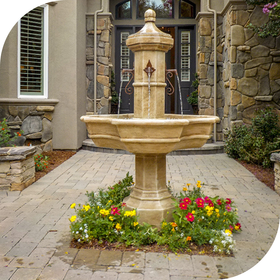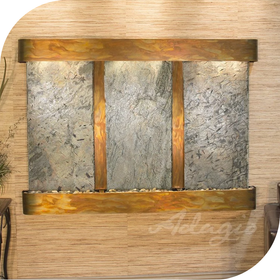Overview
Outdoor fountains enhance gardens by creating a serene atmosphere and attracting wildlife. Incorporating plants around fountains can elevate their aesthetics, provide natural habitats for birds and butterflies, and create a harmonious setting. Key tips include selecting suitable plants, using layering and grouping techniques for placement, and maintaining both plants and fountains properly. Combining diverse textures and using lighting can further enhance the ambiance, making your outdoor space a tranquil retreat year-round.
Outdoor fountains are a beautiful addition to any garden or yard, creating a serene atmosphere while attracting wildlife. But did you know that incorporating plants can significantly enhance the aesthetics and functionality of your fountain? Whether you have a grand concrete fountain or a charming solar bird bath fountain, the right plant choices can create a tranquil oasis. In this article, we will explore how plants can complement your outdoor fountain and transform your space.
The Role of Plants in Fountain Design
Plants play an essential role in the overall design of garden water features. They not only add color and life but also help integrate the fountain into the surrounding landscape. Here are some ways plants can elevate the appearance and impact of your fountain:
1. Create a Natural Setting
When plants are strategically placed around an outdoor fountain, they can mimic a natural setting. The combination of the flowing water from a fountain in a garden with the lush greenery provides a harmonious connection that draws the eye and creates a peaceful atmosphere. Consider using native plants that thrive in your region for a sustainable aesthetic.
2. Provide a Habitat for Wildlife
Integrating plants with your exterior water fountain can attract various birds and butterflies, enhancing the life in your garden. For instance, a solar bird bath or solar water feature surrounded by flowering plants can entice birds to visit, turning your garden into a sanctuary. When planning your plant choices, opt for species that provide food and nesting opportunities for local wildlife.
3. Frame the Fountain
Using plants to frame your fountain creates a focal point in your garden. Tall plants like ornamental grasses or flowering shrubs can provide height and depth to your garden's layout, while shorter plants can create layers. This layering can make the garden fountain appear even more inviting and aesthetically pleasing.
Choosing the Right Plants
When selecting plants to complement your outdoor fountains, consider their size, growth patterns, and compatibility with water features. Here are some popular plant choices that work well with various fountain styles:
1. Grasses and Ferns
-
Ornamental Grasses: Grasses like fountain grass or blue fescue can create a gentle movement and soft sound when the breeze passes through them.
-
Ferns: They thrive in shady, moist areas and can provide a lush backdrop to your fountain while requiring minimal maintenance.
2. Flowering Plants
-
Daylilies: These perennials boast vibrant colors and are drought-resistant, making them a fantastic addition around outdoor fountains.
-
Canna Lily: Known for their bold foliage and striking flowers, canna lilies can add a tropical feel to your outdoor space.
3. Aquatic Plants
If you have a bird bath bowl or any type of water feature, consider adding some aquatic plants. Species such as water lilies or lotus can create a stunning effect, enhancing the beauty of solar water fountains or any garden water features. These plants not only beautify but also provide shade and shelter for fish or frogs, cultivating a thriving ecosystem.
Plant Placement Around Your Fountain
The way you arrange plants around your fountain can have a significant impact on how the entire space feels. Here are some strategies to consider:
1. Layering
Use a layering technique to create depth around your garden fountain. Start with shorter plants in the front and gradually add taller ones behind. This ensures that each plant can be seen and appreciated while not obstructing the view of the fountain. This design also promotes visibility for birds looking for water in solar bird baths or other outdoor fountains.
2. Grouping
Consider grouping plants in clusters that complement each other both in color and texture. For instance, combine soft, feathery plants with bold and spiky varieties to create a dynamic focal point. This method works well with stone bird baths or concrete bird baths, drawing the eye and enhancing the overall garden design.
3. Seasonal Interest
Choose a combination of plants that offer year-round interest. Incorporating a mix of evergreens with seasonal perennials ensures that your outdoor fountain area remains vibrant throughout the seasons. This diversified approach can also enhance the visual appeal of your exterior fountains during every part of the year.
Maintenance Tips for Plants Around Fountains
1. Watering Considerations
Be mindful of the watering needs of both your plants and solar water features. Using a solar bird bath or a concrete fountain can provide moisture for surrounding plants, but they might still require supplemental watering during dry periods. Monitor weather conditions and adjust accordingly to maintain a healthy balance.
2. Pruning and Deadheading
Regular maintenance, such as pruning and deadheading, will keep your plants healthy and encourage more blooms. This task not only enhances your garden's appearance but also ensures that the plants do not overshadow the beauty of the fountain. Well-maintained plants create a cohesive look and enhance the tranquil atmosphere of your outdoor space.
3. Fertilizing Wisely
Be careful when choosing fertilizer, as excessive nutrients can cause algae growth in water features. Use organic fertilizers that are less likely to leach into the fountain system. This will help keep your solar bird bath clean and your garden flourishing without compromising the health of your exterior water fountain.
Create a Relaxing Ambiance
The combination of plants and outdoor fountains offers not only beauty but also tranquility. The gentle sounds of water paired with the rustle of leaves can transform your yard into a peaceful oasis. Some tips to enhance this ambiance include:
1. Creating Shelter
Strategically planting tall shrubs and trees can provide shelter for birds and other garden wildlife. This not only enhances the experience of watching them gather at your bird bath bowl but also adds a level of comfort to your outdoor space.
2. Evening Ambiance
Consider placing solar-powered garden lights among the plants to illuminate your water features after dark. This can create a magical nighttime atmosphere, enhancing the experience of enjoying your exterior fountains even during the evening hours.
3. Incorporate Diverse Textures
Using plants with varying textures enhances the tactile experience of the space. For instance, combining smooth leaves with rough bark creates a richer physical and visual experience when you visit your garden fountain area.
The Perfect Blend of Nature and Water
Incorporating plants to complement your outdoor fountain is a beautiful way to enhance your garden’s aesthetics while attracting wildlife and promoting a serene atmosphere. Whether you have a solar water feature, a stone bird bath, or a concrete fountain, the right plant combinations and arrangements can elevate the entire setting. With thoughtful planning and maintenance, your outdoor oasis can be a stunning retreat year-round.
Start building your dream outdoor space today. Surround your fountains with the perfect plants that will bloom and thrive, creating a beautiful, inviting area that you and the local wildlife can enjoy!






Leave a comment